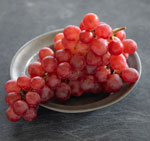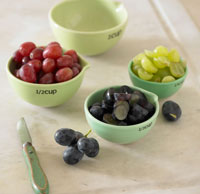Home » Grapes Make the Plate » California Grapes: What a Food Pro Should Know

With its mild, Mediterranean-type climate, California is paradise for grapes. Everyone knows that the Golden State grows world-class wine grapes, but table grapes excel there, too. In fact, California produces almost all of the U.S.’s commercially grown table grapes.

Grapes are the ultimate hand-to-mouth fruit, a wholesome snack that needs no peeling, slicing, coring, or treating to prevent discoloration. They don’t bruise or drip. They don’t require a knife and fork. In short, they are lovable as is.
But for cooks looking to make an impression, grapes have other traits to exploit.

The Thompson Seedless grape was created by Scottish immigrant William Thompson in 1876.
William Wolfskill, a former trapper is credited with planting the first table grape vineyard on land just outside of present-day Los Angeles in 1839.
Juicing
They’re juicy, for one, so why not juice them? As Chef Samuel discovered in the CIA kitchen, a fresh grape puree, strained and reduced, adds fruitiness to a vinaigrette. The same strained puree, uncooked, can be the foundation for a sweet or savory coulis. Chef Samuel adds crème fraîche, lime juice, honey, cayenne, and salt to make a cool, tropical sauce for grilled fish. But you could omit the savory seasonings and use the grape coulis on an updated “shortcake” made with grilled poundcake, warmed grapes, and whipped cream.
Roasting
Grapes have abundant natural sugar, so why not roast them? Roasting heightens the flavor and caramelizes the sugars, giving the exterior an appetizing glaze. You can roast them in a slow oven, as Chef Samuel did for Ajo Blanco with Slow-Roasted Grape and Extra Virgin Olive, or you can roast them fast, as he did for Roasted Red Grape, Octopus, and Fingerling Potato Salad with Lime Aioli.
“The slow roast concentrates the flavor without caramelization,” says the chef. “I did it slow for the soup because I wanted the grapes to retain their shape and not burst. With the octopus, I wanted the richness of caramelization. But don’t over-roast them. They can go from caramelized to burnt pretty quickly.”
You can roast the grapes on the stem or off. Chef Samuel prefers to roast the whole clusters and then remove the individual grapes. “You get more variety of flavor,” says the chef. “The outside grapes get more heat and color, while the inside ones stay juicier.”
Frying
Chef Samuel also made what may be the world’s first fritto misto with grapes. Yes, you can fry grapes, and they make an inspired addition to this Italian antipasto. The chef was hoping that the fried grapes would produce a compelling contrast of crisp and juicy and enhance a vegetarian fritto misto. He added fennel and lemon slices to the batter, and paired this innovative mixed-fry with lemon crème fraîche. Brilliant, but it took some tinkering.
“When I tried frying the grapes unfrozen, they burst immediately and got oily,” says the chef. “So I thought to freeze them first so they would hold their shape. The batter has a chance to cook before the grape gets too hot, so you have a room-temperature grape in a crispy batter.”
Featured Recipe: Watch Chef Samuel prepare his surprising Fritto Misto of Grapes, Fennel, and Lemons with Lemon Crème Fraîche.
Featured Recipe: Never roasted grapes? Watch Chef Samuel prepare Roasted Red Grape, Octopus, and Fingerling Potato Salad with Lime Aioli.
Chefs active in the realm of molecular gastronomy are getting attention for manipulating ingredients in ways never imagined. Some of their experiments work, some don’t, but they deserve praise for nudging all cooks to unleash the potential in their raw materials.
What else can you do with a fresh table grape besides eat it (always a good idea), heat it, peel it, or puree it? Chef Samuel challenged himself to probe the frontiers of possibility and made an intriguing discovery.

“The idea came from one of my colleagues,” says Samuel of his effort to carbonate grapes. “You put the grapes in a whipping-cream canister with wine and then charge it. You have to prick the grapes first. When I didn’t prick them, they exploded. Pricking gives them the ability to transmit pressure. When you take the grapes out, they’re fizzing, like soda pop. It’s an easy way to do something really unique. You get that punch of flavor in your mouth.”
Hyde Park, NY Location
1946 Campus Dr. | Hyde Park, NY 12538
Maps & Directions
Napa, CA Location
500 First Street | Napa, CA 94559
Maps & Directions
Singapore Location
21 Tampines Ave 1 Block 31 | Singapore 529757
Maps & Directions
St. Helena, CA Location
2555 Main St. | St. Helena, CA 94574
Maps & Directions
San Antonio, TX Location
312 Pearl Pkwy, Bldg 3 | San Antonio, TX 78215
Maps & Directions